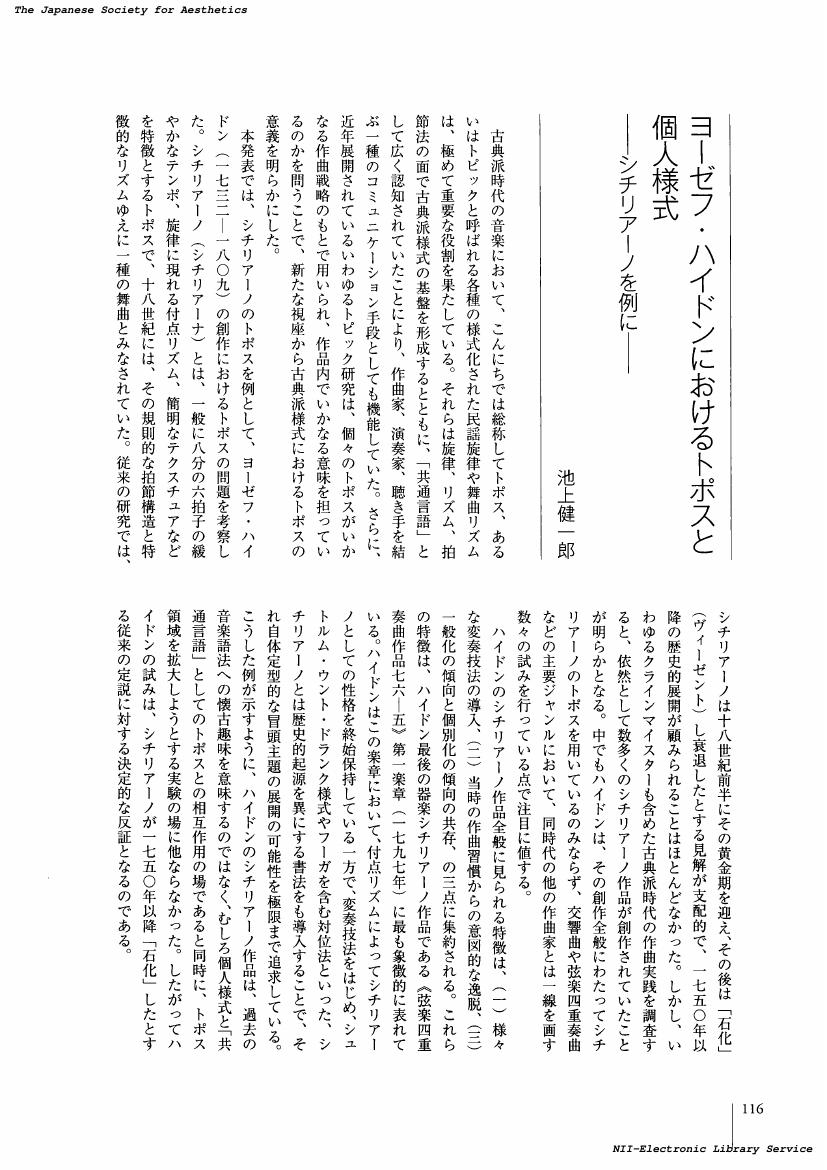- 著者
- 堀内 義隆 下條 尚志 川上 桃子 青木(岡部) まき 池上 健慈
- 出版者
- 独立行政法人 日本貿易振興機構アジア経済研究所
- 雑誌
- アジア経済 (ISSN:00022942)
- 巻号頁・発行日
- vol.63, no.4, pp.61-80, 2022-12-15 (Released:2022-12-26)
- 参考文献数
- 3
2 0 0 0 IR 「二重の存在」としてのブルックナー : 《交響曲第9番》第3楽章(アダージョ)における自律性と標題性をめぐって (特集 論集 美学・芸術学 : 美・芸術・感性をめぐる知のスパイラル(旋回))
- 著者
- 池上 健一郎
- 出版者
- 三田哲學會
- 雑誌
- 哲学 (ISSN:05632099)
- 巻号頁・発行日
- vol.132, pp.309-341, 2014-03
特集 : 論集 美学・芸術学 : 美・芸術・感性をめぐる知のスパイラル(旋回)The symphonies of Anton Bruckner (1824‒1896) were evaluated both during his lifetime and subsequent to his death in terms of two opposing criteria : "absolute music" and "program music", terms that actually reflect aesthetic polemics. Especially since the 1980s, Bruckner scholarship has connected this dichotomy to methodological discussions of autonomic analysis and semantic interpretation. However, the methodological purism being undeniably at stake in both positions comes with the risk of misconceiving the multiple layers of Bruckner's symphonies.Hence my paper aims at demonstrating that both dimensions—the "purely musical" and the semantic—make up an inseparable unit in Bruckner's music. The third movement of his Ninth Symphony seems particularly suitable for this purpose, since Bruckner himself commented on its "content" on various occasions.By means of analysis, I seek to demonstrate how thematic ideas being integrated into a broader motivic network throughout the symphony are interlinked semantically. Remarkably, such "semantic networks" are strengthened through thematisch-motivische Arbeit, the technique which is commonly regarded as the "autonomous" principle. Along those lines, the culmination of the movement (mm.187ff.) gains a multidimensional character. In order to understand the related nature of Bruckner's "Doppeldasein"(Korte), the methodological purism ought to be overcome.
- 著者
- 池上 健一郎
- 出版者
- 美学会
- 雑誌
- 美学 (ISSN:05200962)
- 巻号頁・発行日
- vol.63, no.2, pp.116, 2012-12-31 (Released:2017-05-22)
- 著者
- 池上 健一郎
- 出版者
- 美学会
- 雑誌
- 美学 (ISSN:05200962)
- 巻号頁・発行日
- vol.56, no.3, pp.51, 2005-12-31 (Released:2017-05-22)
- 著者
- 川村 静児 中村 卓史 安東 正樹 坪野 公夫 沼田 健司 瀕戸 直樹 高橋 龍一 長野 重夫 石川 毅彦 植田 憲一 武者 満 細川 瑞彦 佐藤 孝 佐藤 修一 苔山 圭以子 我妻 一博 青柳 巧介 阿久津 智忠 浅田 秀樹 麻生 洋一 新井 宏二 新谷 昌人 井岡 邦仁 池上 健 石徹白 晃治 市耒 淨興 伊藤 洋介 井上 開輝 戎崎 俊一 江里口 良治 大石 奈緒子 大河 正志 大橋 正健 大原 謙一 奥冨 聡 鎌ヶ迫 将悟 河島 信樹 神田 展行 雁津 克彦 木内 建太 桐原 裕之 工藤 秀明 國森 裕生 黒田 和明 郡和 範 古在 由秀 小嶌 康史 小林 史歩 西條 統之 阪上 雅昭 阪田 紫帆里 佐合 紀親 佐々木 節 柴田 大 真貝 寿明 杉山 直 宗宮 健太郎 祖谷 元 高野 忠 高橋 忠幸 高橋 弘毅 高橋 竜太郎 田越 秀行 田代 寛之 田中 貴浩 谷口 敬介 樽家 篤史 千葉 剛 辻川 信二 常定 芳基 徳成 正雄 内藤 勲夫 中尾 憲一 中川 憲保 中野 寛之 中村 康二 西澤 篤志 丹羽 佳人 野沢 超越 橋本 樹明 端山 和大 原田 知広 疋田 渉 姫本 宣朗 平林 久 平松 尚志 福崎 美津広 藤本 眞克 二間瀬 敏史 前田 恵一 松原 英雄 水澤 広美 蓑 泰志 宮川 治 三代木 伸二 向山 信治 森澤 理之 森脇 成典 柳 哲文 山崎 利孝 山元 一広 横山 順一 吉田 至順 吉野 泰造
- 出版者
- 一般社団法人日本物理学会
- 雑誌
- 日本物理学会講演概要集 (ISSN:13428349)
- 巻号頁・発行日
- vol.61, no.1, 2006-03-04


